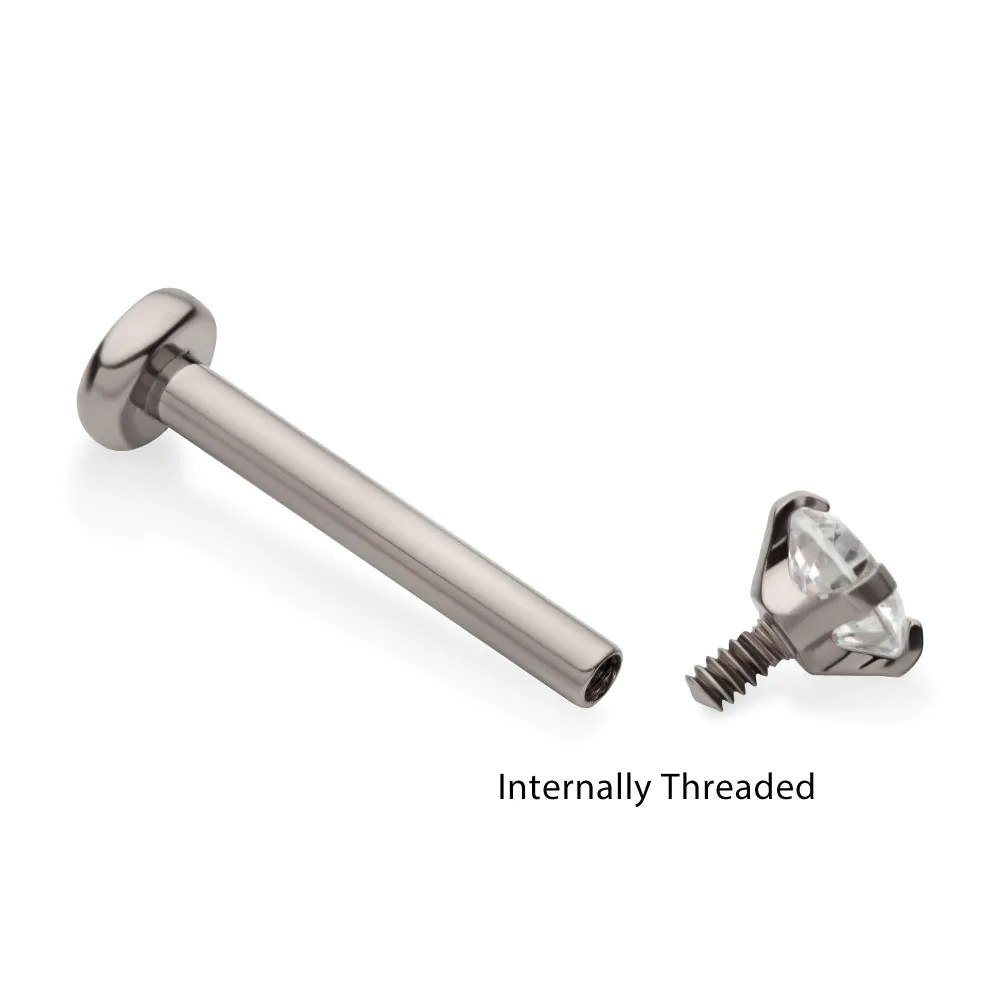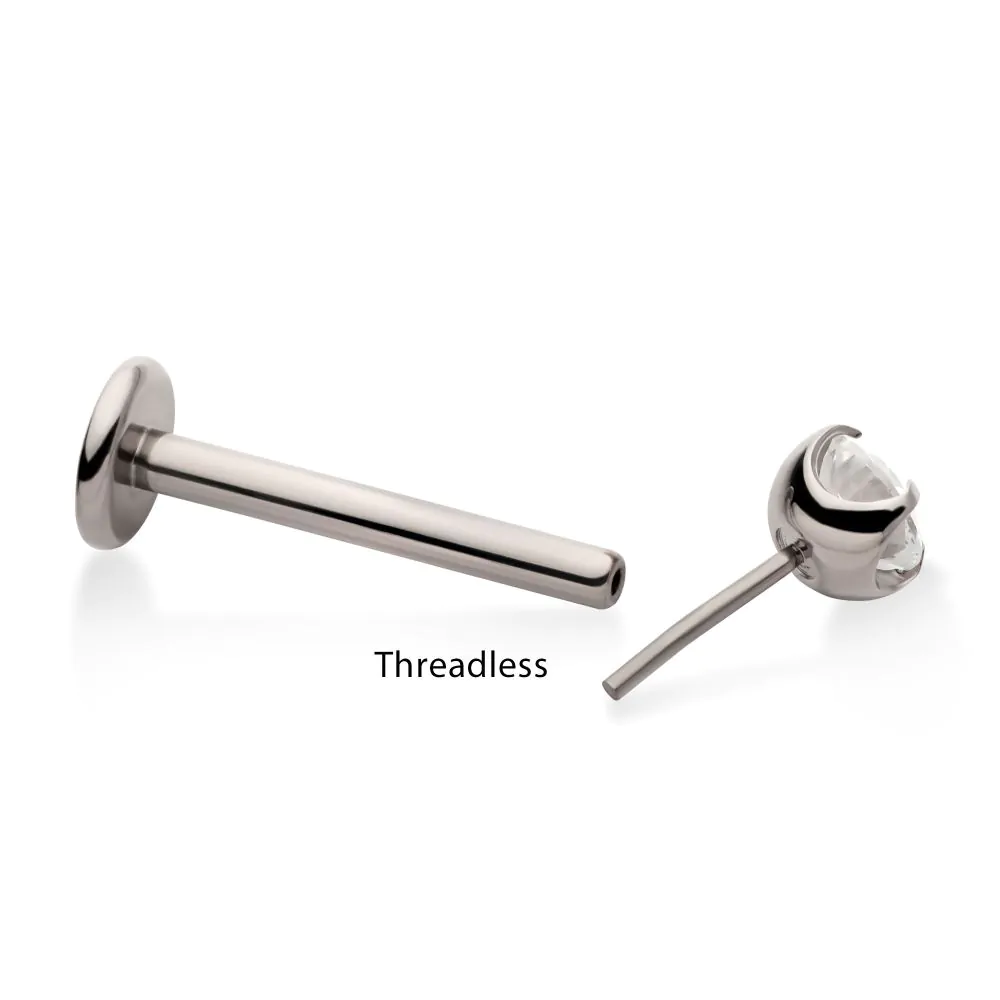Whether getting a new piercing or switching out your jewelry, choosing the right body jewelry is essential for comfort and safety. Understanding the types of body jewelry will help you make an informed decision tailored to your wants and needs.
In this blog, we will discuss different styles of jewelry threading and why it matters.
What is Threading?
Threading in body jewelry refers to the ridges and grooves that are used to screw components together. These components are the decorative end and the post. The threading determines how jewelry is inserted and removed, and how secure it is once in place.
Why Does Threading Matter?
The jewelry you wear plays a crucial role in the overall health and longevity of your piercing.
What Kinds of Threading are There?
There are three types of threading used in body jewelry; internal threading, external threading and threadless aka push-fit.
Internally Threaded Body Jewelry
What does it look like?
The post: Has a smooth exterior with internal threads hidden inside the hollow center.
The attachment (such as a ball or decorative end): Has a small stem that screws into the hollow post.

Many professional piercers follow industry standards that recommend or require the use of internally threaded jewelry for initial piercings. This preference is based on extensive experience and evidence supporting the benefits of internally threaded designs.
Here’s Why I love it...
1. Reduced Risk of Irritation: Internally threaded jewelry has a smooth exterior, which reduces the risk of causing micro-tears or abrasions to the piercing channel during insertion and removal. This is particularly important for fresh piercings, where the tissue is more delicate.
2. Security: The internally threaded design allows for a more precise and tight connection between the post and the end piece. The internal threads in the post align perfectly with the external threads on the decorative end, ensuring a snug fit.
My rating
Comfort 5/5
User Friendliness 3/5
Safety 5/5
Jewelry options 4/5
Security 4/5
Externally Threaded Body Jewelry
What does it look like?
The post: has visible ridges or grooves on its exterior surface.
The attachment (such as a ball or decorative end): has a hollow part with corresponding threads inside, allowing it to screw onto the post.

Externally threaded jewelry can be found easily and often at a low price point. This may sound great, but it has several drawbacks.
Here’s Why I Don't Love it...
Increased Risk of Irritation: The main issue is the exposed threads, which are harmful to new or sensitive piercings. The rough texture can be uncomfortable and cause micro-tears in the skin as the jewelry is inserted or removed. This increases the risk of irritation and can extend healing time by re-injuring tissue that had begun to heal. Even if your piercing is years old, external threading still has the potential to injure or irritate your piercing.
Lack of Security: The threading mechanism often lacks the precision found in internally threaded designs. The external threads might not align as perfectly with the screw-on end, leading to a less secure connection. Without a secure and precise fit, the end piece can easily become unscrewed, leading to the jewelry falling out. Additionally, the threads can become worn down or stripped over time, so the end piece will not stay securely attached.
Bacterial Nightmare: Tissue from the piercing channel, dirt and other contaminants can get stuck in the threads themselves, making thorough cleaning challenging. And, as mentioned, the external threads can cause micro-tears in the skin providing - providing entry points for these contaminants and bacteria.
Despite these disadvantages, externally threaded jewelry is popular and affordable. This style is what you’ll find at jewelry stores in the mall (I’m looking at you, Spencer’s). This jewelry should never be used in new piercings. Instead, stick to high-quality jewelry from reputable shops (physical or online). Quality over quantity, friends.
My Rating
Comfort 2/5
User Friendliness 3/5
Jewelry options 4/5
Security: 2/5
Threadless Body Jewelry
What does it look like?
The Post: The post is hollow and smooth, without any ridges or grooves.
The attachment (such as a ball or decorative end): Has a pin that gets slightly bent. This pin fits into the hollow post and is held in place by pressure, not threads.
Threadless jewelry features a unique pressure-fit mechanism that secures the jewelry without threads.

Here’s Why I love it...
Reduced Risk of Irritation: The smooth post and absence of threading mean there are no rough surfaces or edges that can irritate or damage the piercing channel. This makes threadless jewelry a great option for new, healing and old piercings.
Security: Despite lacking threads, threadless jewelry is secure. The slight bend in the pin allows it to be securely held in position by the pressure exerted between the post and the decorative end. This creates a tight connection that keeps the jewelry securely in place.
Versatility: With push-fit jewelry, you can detach one decorative end and replace it with another, without removing the entire piece of jewelry. Swapping out the ends is straightforward and can be done without the need for special tools. This also means that Instead of purchasing multiple pieces of jewelry, you can buy one single post and several ends.
Threadless jewelry is favoured in our studios for its user-friendly design and comfort. It is incredibly easy to insert and remove and is ideal for clients who frequently change their jewelry.
My Rating
Comfort 5/5
User Friendliness 4/5
Safety 5/5
Jewelry options 5/5
Security 5/5
Visual Summary:
Internal Threading: Smooth post exterior, hidden internal threads. Decorative top screws into the post.
External Threading: Visible ridges or grooves on the post exterior. Decorative top screws onto the post.
Threadless: Smooth post, no threads. The decorative top pushes into the hollow post.
Overall Ratings:
Internal Threading: 21/25
External Threading: 12/25
Threadless: 24/25
Making the Right Choice
When choosing body jewelry, consider the type of piercing, the healing stage, and your personal preferences. Internally threaded or threadless jewelry is best for new piercings due to its smooth designs and reduced risk of irritation. Externally threaded jewelry can be suitable for healed piercings but should be used cautiously to avoid unnecessary discomfort. By understanding the differences between these three types of body jewelry, you can make an informed decision that ensures the best possible outcome for your piercings. Always consult with a professional piercer if you’re unsure!
